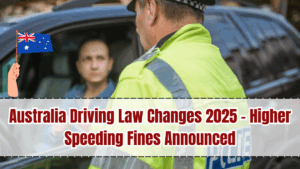The Australian government has introduced significant updates to its driving laws in 2025, focusing particularly on speeding-related offenses. The new Australia Driving Law 2025 brings higher fines, additional demerit points, and stricter enforcement for drivers who exceed speed limits.
This change follows growing concerns about road safety, as speeding continues to be one of the leading causes of accidents and fatalities nationwide. For motorists, the new penalties mean stricter compliance is now essential to avoid heavy fines and license suspensions.

Why Speeding Penalties Are Increasing in 2025
The decision to introduce higher speeding fines stems from:
-
Rising Road Fatalities: Speeding contributes to more than 30% of road deaths in Australia each year.
-
Repeat Offenders: Many drivers continue to speed despite existing penalties.
-
Public Safety Campaigns: Advocacy groups demanded tougher laws to deter reckless driving.
-
International Standards: Aligning with global road safety practices adopted by OECD countries.
-
Technology-Backed Enforcement: New AI and speed detection systems make stricter monitoring possible.
Updated Speeding Fines – 2025 Changes
The penalties have been revised significantly across all states and territories, though final amounts may vary slightly. Below is the general framework for late 2025 speeding laws:
-
Low-Range Offenses (1–10 km/h over the limit):
-
Fine: $300–$400 AUD.
-
Demerit Points: 2 points.
-
-
Mid-Range Offenses (11–20 km/h over the limit):
-
Fine: $600–$750 AUD.
-
Demerit Points: 3–4 points.
-
-
High-Range Offenses (21–30 km/h over the limit):
-
Fine: $900–$1,200 AUD.
-
Demerit Points: 5 points.
-
-
Serious Offenses (31–45 km/h over the limit):
-
Fine: $1,500–$2,200 AUD.
-
Demerit Points: 6–7 points.
-
Possible suspension: 1–3 months.
-
-
Extreme Offenses (45+ km/h over the limit):
-
Fine: $3,000–$3,500 AUD.
-
Immediate license suspension of 6–12 months.
-
Vehicle impoundment in some states.
-
Demerit Point System – Tougher Rules
The demerit point system has also been strengthened:
-
Learner and P-plate drivers face automatic suspensions for exceeding thresholds.
-
Repeat offenders within 12 months may receive double demerit penalties.
-
High-risk areas like school zones and construction sites carry extra penalties.
Technology and Enforcement in 2025
The reforms are supported by expanded use of:
-
AI Speed Cameras: Capable of identifying both speed and driver behavior.
-
Average Speed Cameras: Monitor speed over long stretches, not just single points.
-
Police Patrols: Increased presence in accident-prone zones.
-
Mobile Phone Detection Integration: Cameras can now simultaneously check for phone use and speeding violations.
Impact on Drivers and Communities
The new penalties will affect motorists in multiple ways:
-
Higher Costs: Fines reaching $3,500 make violations financially severe.
-
License Suspensions: More drivers risk losing licenses due to higher demerit points.
-
Professional Drivers: Truckers, delivery drivers, and taxi operators face higher risks of losing livelihoods.
-
Community Safety: Expected reduction in speeding-related fatalities and injuries.
Benefits of the New Speeding Penalties
Despite concerns about higher fines, the policy brings several benefits:
-
Deterrence Effect: Drivers are less likely to speed due to steep penalties.
-
Fewer Accidents: Stricter enforcement reduces risks of fatal crashes.
-
Consistency: Uniform rules across states make compliance clearer.
-
Technology Efficiency: Automated systems reduce human error in monitoring.
Public Concerns
Critics of the new speeding laws argue:
-
Excessive Fines: May disproportionately affect low-income drivers.
-
Over-Reliance on Cameras: Concerns about unfair penalties in certain conditions.
-
Impact on Rural Areas: Drivers in remote areas argue that long roads often encourage slightly higher speeds.
-
Revenue vs. Safety Debate: Some see fines as government revenue rather than pure safety measures.
Tips for Motorists in Late 2025
-
Stay within limits, especially in school zones and construction areas.
-
Use cruise control on highways to avoid unintentional speeding.
-
Pay attention to variable speed signs in urban areas.
-
Check demerit point balances regularly via state road authority portals.
-
Treat penalties as a serious deterrent, not just a financial inconvenience.
Conclusion
The Australia Driving Law Changes 2025 highlight the government’s strong stance on road safety by imposing higher speeding fines and stricter penalties. With fines reaching $3,500 AUD and immediate suspensions for extreme violations, motorists must adopt more responsible driving habits.
While concerns remain about fairness and affordability, the long-term benefits of safer roads, fewer accidents, and stronger public trust in traffic laws are clear.
FAQs
What are the new fines for speeding in 2025?
Fines range from $300 AUD for low-level offenses to $3,500 AUD for extreme speeding.
Will demerit points also increase?
Yes, violations can now result in 2–7 demerit points, with stricter rules for repeat offenders.
Are penalties the same across all states?
The framework is uniform, but exact fines may vary slightly by state or territory.
What happens for extreme speeding violations?
Drivers may face fines of up to $3,500, immediate license suspension, and in some cases, vehicle impoundment.
How will speeding be monitored in 2025?
Through AI-powered cameras, average speed systems, and increased police patrols.
Click here to know more.




